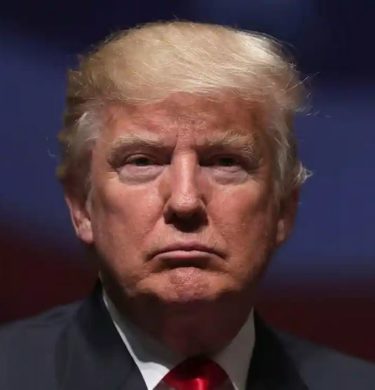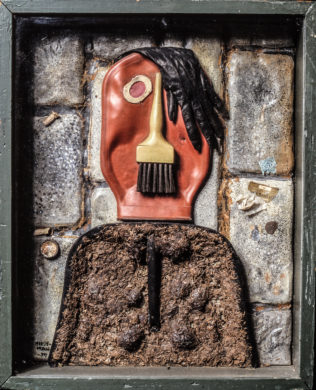Would Lou Hirshman, were he still alive today, have ever done a caricature of Donald J. Trump?

The answer is no. For at least three reasons.
1) Too easy: Although the 45th president of the US is (or was?) ripe for caricaturizing, Hirshman would undoubtedly have already considered Trump a caricature of himself – artificially tanned face, cartoonish orange hair, small hands, a Benito Mussolini scowl, sex scandals, and so on. Using found objects to lampoon him as a caricature would have been easy, but redundant. Tackling him as a caricature would have been like creating the visual equivalent of a cheap gag: “Donald Trump and Joe Biden walk into a bar…” That was not Hirshman’s kind of humor.
2) Too trendy: The image of Trump has already been exploited as the butt of countless visual exaggerations. The internet and social media are awash with “unique” caricaturized Trumps in innumerable drawings, cartoons and memes. For Hirshman, while he certainly had the skill and wit to find the ridiculous essence of “The Donald” in found objects, re-imagining the image of Trump would have held little interest in such a crowded field.
3) Too late: The simplest explanation of why Trump would have escaped Hirshman’s razor-sharp humor is that the artist had simply stopped doing caricatures of people in the public eye in 1964. Most likely, Hirshman had lost the lust for a genre where he was often pigeon-holed as “that guy who makes fun of the famous wi,th junk.”
And thus even if Hirshman (1905–1986), had he lived until 2020 when he would have been 115 years old, he still would have never turned Trump into political caricature.
The Smell of Visual Shit

This, however, is not to sa,y that Hirshman was apolitical. Far from it. Although he never voted in an election (the reason will be made clear later), one could make the argument that this “sophisticated junk collector,” as one observer described him,” voted with the materials he selected for his artwork – old shoes, dirty socks, self-crafted sardines, smelly shit, etc. Of the 24 documented caricatures he did of the famous during the three decades of his second artistic period, spanning the years from the mid-1930s till the first half of the 1960s, nearly two-thirds were explicitly political. The list ranged from Ethiopia’s emperor Haile Selassie in 1935 to French president Charles de Gaulle in 1964.

In the pre-World War II period, Hirshman aimed his genius at the rising tensions around the globe, specifically in the Berlin-Rome-Tokyo Axis powers – pre-Kristallnacht German fascist dictator Adolf Hitler in 1937; Italian despot Benito Mussolini in 1937; and Japan’s general and prime minister Hideki Tojo in 1943. (His Tojo was Hirshman’s only wartime found-object caricature, done just before being called up by the US Army to serve in the war effort.)
The Fear Factor
Immediately after the war, for more than a decade, Hirshman basically put his creation of caricatures on the back shelf. That meant he produced nothing concerning politics.
And that was almost certainly due to fear.
Back in the 1930s, many American intellectuals and members of labor groups joined the Communist Party. Although Hirshman wasn’t one of them, he was certainly a leftist who had had some dealings with the party. A photo of a Hirshman caricature of British Prime Minister Neville Chamberlain, who had made a controversial appeasement with Hitler before the war, appeared in the January 1939 edition of New Masses, an American Marxist magazine closely associated with the US Communist Party. The year before, a black-and-white copy of his Hitler piece had been published in the US Communist paper The Daily Worker. In 1937 he had made two caricatures, which while somewhat unflattering – one of a rat-moustachioed Russian Marxist revolutionary Leon Trotsky and the other the bureaucratic bureau-chested Soviet dictator Joseph Stalin – could have marked him as suspicious in governmental eyes.

The post-war years were a time of right-wing, witch-hunting politicians stirring up an anti-Communist Red Scare that swept the US. During the McCarthy era in the 1950s, the American government tried to track down Communists by calling many of those of suspected of party membership to testify before investigating committees. This mania probably spooked the artist. Hirshman’s name can be found in a 1952 transcript of the US House of Representatives’ Committee on Un-American Activities hearing that was looking into Communist activities in around Philadelphia, Hirshman’s hometown. It included details of an event entitled “Help Democratic Spain,” referring to the Communist’s fight against Fascists in Spain. While Hirshman was only listed as the maker of masks for a stage production of the Communist Party Cultural Committee, even that could have been enough to get him subpoenaed by the government. It had already happened to several of Hirshman’s in-laws.
Hirshman was not called. And it was fortunate. According to one of his relatives, Hirshman, whose Jewish family had immigrated from what was then part of the Soviet Union and now Ukraine to the US through Ellis Island in 1909, never became a naturalized citizen of his adopted country, a requirement for citizenship. Which means he may not have been a legal resident of the US and possibly could have been sent back to Russia as an illegal alien. This would certainly answer the question of why he never voted. As a result, it is understandable that Hirshman would not want to call attention to himself via political satire in such uncertain times.
A Farewell to Fame



Eventually, however, he did start doing caricatures again, mostly of politicians. In 1963, he created political caricatures of a triad of nuclear Cold War warriors – the Soviet Union’s Nikita Khrushchev, Cuba’s Fidel Castro and US president John F. Kennedy. When Kennedy was assassinated in November of that year, Hirshman took down the caricature of the slain president from his living room wall, never to be put up again. After the killing of Kennedy he pretty much lost his taste for the genre. Except for the de Gaulle piece finished the following year, he stopped doing caricatures of the well known altogether. Instead, it seems he wanted to stretch his wings as a serious, but still humorous artist with caricaturizing archetypes, nudes, animals and moving toward surrealism.
But that doesn’t mean politicians never felt his sting again. In 1976, Hirshman made one of his many archetype caricatures, this one called Politician. It showed a bland, balding campaigner at a podium but with sardine teeth and a rat lapel pin staring down at a Swiss cheese handkerchief protruding from his suit jacket breast pocket.
As for Trump, it’s hard to imagine that the blowhard president would ever have become a member of the Hirshman portfolio.
Still, in a way, Trump can already be found in the Hirshman collection. In 1964, as Hirshman started distancing himself from taking the mickey out of the famous, he produced what now could be seen as a premonition of the Trumpian hell to come. It showed a massive crowd of cowed buttons with vacant buttonhole eyes mesmerized by a raging orator with hangman noose fingers and bullet teeth.

It was titled The Dictator.



